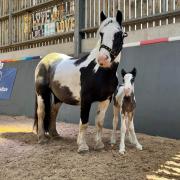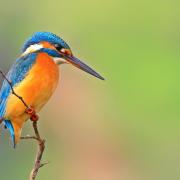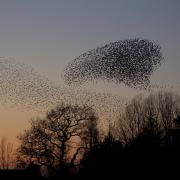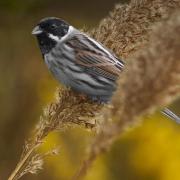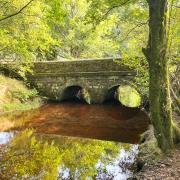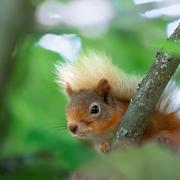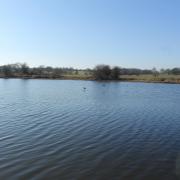Water vole numbers have plummeted in the last 10 years caused mainly by a 30 per cent decline in their habitats. The Carbon Landscape’s Katie Chambers goes on a search for these rare mammals.

Being involved with wildlife conservation, it is pretty much a given that at some point you will have the pleasure of a welly full of ice-cold ditch water. As a passionate nature enthusiast, you will take that hit. That’s because you are out there, in the field and part of efforts to preserve that wildlife for future generations.
This is how I felt, while standing in a stream and slowly sinking into silt, welly full to the brim, sock soaked through and with no feeling in my right foot. Despite this incident on a chilly day, it was worth it to be out surveying for signs of one of our most treasured, yet threatened, mammals; the water vole.
Water vole numbers have plummeted in the last 10 years, there has been a 30 per cent decline in places where these river mammals once lived in England and Wales.
The Wildlife Trusts’ efforts have seen a slight increase in the distribution of water voles in the last couple of years. And the Wildlife Trust for Lancashire, Manchester and North Merseyside has been at the forefront of the revival with habitat work at is mosses in Salford, Garstang and Heysham and at Wigan Flashes and Lunt Meadows in Merseyside.

As part of my work, as a trainee on the Heritage Lottery-funded Carbon Landscape project, I carried out a survey at Highfield Moss, near Wigan.
We crept along the ditch bank that bordered the edge of Highfield Moss and inspected every burrow we found to see if it was the correct size, looking as well for signs of any feeding activity as well as latrines.
We did come across two burrows that looked to be potentially be water vole-sized, so we marked these with poles and a precautionary approach has been taken to keep any habitat work at least five metres away from those areas.
Water voles are ecosystem engineers – their burrowing and feeding behaviour along the edges of watercourses creates the conditions for other animals and plants to thrive. Kingfishers, for example, often use water vole excavations for nests.

Habitat loss, water pollution and built development have led to massive declines in the number of water voles since the 1960s – this has been exacerbated by predation by North American mink which was introduced to Britain for fur farming in the 20th century. The water vole is the UK’s most rapidly declining mammal and has been lost from 94 per cent of places where they were once prevalent. The latest data revealing a 10-year decline of 30 per cent shows an ever-worsening situation: their range is continuing to contract.
The Carbon Landscape team shares an office with the Wildlife Trust’s Wigan officers and Wigan Projects Manager Mark Champion said: ‘We have completed some work for water voles concentrating on ditches and at Wigan Flashes. Our recent successful re-wetting work has created some great water vole habitat at Highfield Moss. Our mossland work across the region is aimed at providing excellent habitats for many creatures including the water vole.’
During early work on Lunt meadows in Merseyside, water vole surveys were carried out and water voles were spotted. Work on providing a flood defence for the River Alt included creating bridges for water voles to cross.
Signs of water voles have been found at Cadishead and Astley Moss and at the remote Winmarleigh Moss close to Garstang.

Water voles used to be regularly seen and heard along ditches, streams and rivers across the UK. A creature which burrows in banks and feeds on reeds and grass, the water vole was a lead character, known as Ratty, in Kenneth Grahame’s children’s classic Wind in the Willows.
I will be returning to the survey years in the coming months in the hope that I will see a water vole.
The Carbon Landscape
Trainee placement Katie Chambers is having lots of nature moments working for the Carbon Landscape. Her water vole surveys are just part of a role that is helping to restore an industrial landscape for wildlife and health benefits for people.
That industrial landscape that dominated South Lancashire is becoming one of the greenest areas of the North West – a wilderness among millions of homes.
The Carbon Landscape project is bringing together previous restoration achievements with new works without losing sight of the ground-breaking heritage that made the region famous.
Made up of a number of environmental partners across mossland and wetland areas it is helping to reconnect people with the land. You can find more details online at carbonlandscape.org.uk
Get involved
The Wildlife Trust for Lancashire, Manchester and North Merseyside is dedicated to the protection and promotion of the wildlife in Lancashire, seven boroughs of Greater Manchester and four of Merseyside, all lying north of the River Mersey. It manages around 40 nature reserves and 20 Local Nature Reserves covering acres of woodland, wetland, upland and meadow. The Trust has 29,000 members, and over 1,200 volunteers.
To become a member of the Trust go to the website at www.lancswt.org.uk or call 01772 324129.




